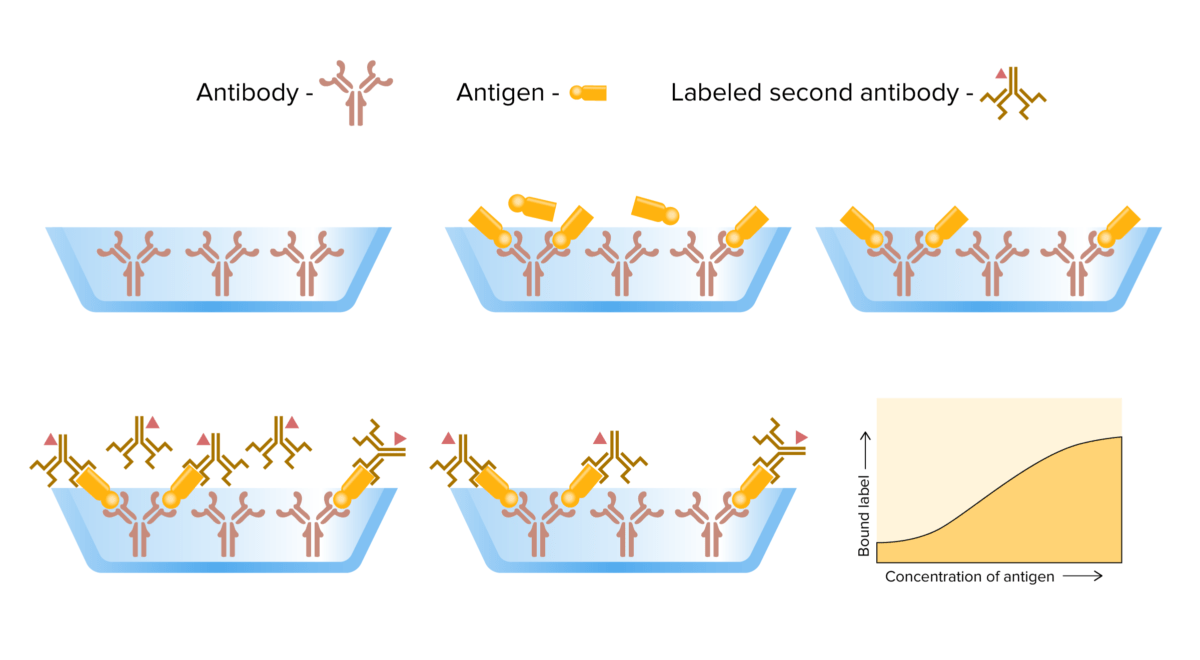Immunoassays are plate-based techniques that can detect and quantify many types of molecules through antibody-antigen reactions. An immunoassay typically involves an analyte, a targeted antibody, and labels. Classification of immunoassays is based on the type of label utilized, which includes enzymes (ELISA), light-emitting molecules/tracers (e.g., chemiluminescence and fluorescence immunoassays), and radioactive isotopes (radioimmunoassays). These specialized immunoassays are relatively sensitive, specific, inexpensive, and rapid, and are widely used in a clinical setting. Immunoassays are used in the diagnosis of infectious diseases, identification of tumor markers, allergy testing, and monitoring drug levels.
Last updated: Sep 27, 2022
Immunoassays are plate-based assay techniques designed for detecting and quantifying peptides, proteins Proteins Linear polypeptides that are synthesized on ribosomes and may be further modified, crosslinked, cleaved, or assembled into complex proteins with several subunits. The specific sequence of amino acids determines the shape the polypeptide will take, during protein folding, and the function of the protein. Energy Homeostasis, antibodies Antibodies Immunoglobulins (Igs), also known as antibodies, are glycoprotein molecules produced by plasma cells that act in immune responses by recognizing and binding particular antigens. The various Ig classes are IgG (the most abundant), IgM, IgE, IgD, and IgA, which differ in their biologic features, structure, target specificity, and distribution. Immunoglobulins: Types and Functions, and hormones Hormones Hormones are messenger molecules that are synthesized in one part of the body and move through the bloodstream to exert specific regulatory effects on another part of the body. Hormones play critical roles in coordinating cellular activities throughout the body in response to the constant changes in both the internal and external environments. Hormones: Overview and Types. The most crucial element of the detection strategy is a highly specific antibody-antigen reaction.
The type of label defines the immunoassay being performed:
There are 4 major types of ELISA ELISA An immunoassay utilizing an antibody labeled with an enzyme marker such as horseradish peroxidase. While either the enzyme or the antibody is bound to an immunosorbent substrate, they both retain their biologic activity; the change in enzyme activity as a result of the enzyme-antibody-antigen reaction is proportional to the concentration of the antigen and can be measured spectrophotometrically or with the naked eye. Many variations of the method have been developed. St. Louis Encephalitis Virus, which are variations of the general immunoassay process:

Mechanism of direct ELISA: A target antigen is added to a plate along with enzyme-labeled antibodies specific to that antigen. After incubation, the excess unbound antibodies are removed by washing and a substrate is added. In the presence of the enzyme label, a reaction occurs that results in a color change.
Image by Lecturio.
Mechanism of indirect ELISA: A target antigen is added to a plate coated with primary antibodies. An antibody-antigen complex is formed after incubation. Excess antibody is removed by washing, and secondary enzyme-labeled antibodies are added, which bind to the antibody-antigen complex. Excess antibodies are washed away and the substrate is added. Presence of the enzyme label results in a color change.
Image by Lecturio.
Mechanism of sandwich immunoassay:
From left to right: Analyte antigen is added to an antibody-coated plate. Unbound antigens are removed by washing, and secondary enzyme-labeled antibodies are added, which bind to the antigens. The excess unbound, labeled antibodies are removed by washing. The substrate is added and the resulting color change is detected/measured.

Mechanism of competitive ELISA:
From left to right: A target antigen and enzyme-labeled antigen are added to an antibody-coated plate. The antigens compete for binding to the antibodies. Next, a substrate is added and the subsequent color change is detected/measured. Unlike other forms of immunoassays, less color change indicates a higher concentration of the target antigen (as it does not contain the enzyme label).
Immunoassays have a wide range of clinical applications. The examples listed below are not exhaustive.
Immunoassays can be used to directly identify microorganisms (based on antigens or toxins) or indirectly assess for antibodies Antibodies Immunoglobulins (Igs), also known as antibodies, are glycoprotein molecules produced by plasma cells that act in immune responses by recognizing and binding particular antigens. The various Ig classes are IgG (the most abundant), IgM, IgE, IgD, and IgA, which differ in their biologic features, structure, target specificity, and distribution. Immunoglobulins: Types and Functions to the infectious agent. Some examples include:
Immunoassays can be utilized to detect tumor Tumor Inflammation markers. Examples include:
Immunoassays can be used to detect IgE antibodies IgE antibodies An immunoglobulin associated with mast cells. Overexpression has been associated with allergic hypersensitivity. Type I Hypersensitivity Reaction to specific allergens:
Therapeutic drug monitoring is an important application of immunoassays. Examples include monitoring the drug levels of:
Additional laboratory tests where immunoassays may be utilized include:
Advantages depend on the type of immunoassay used; however, generally, they are: